| Revision as of 13:47, 14 July 2012 editTakeaway (talk | contribs)Extended confirmed users, Pending changes reviewers, Rollbackers18,258 edits →Vernacular names: minor CE← Previous edit | Revision as of 22:19, 1 August 2012 edit undoElbeau (talk | contribs)13 edits Added information about the "Second harvest" of the pitahayaNext edit → | ||
| Line 56: | Line 56: | ||
| Ingestion of significant amounts of red-fleshed dragon fruit (such as Costa Rica Pitaya) may result in ], a harmless reddish coloration of the urine and faeces.<ref>MMR (2008)</ref> | Ingestion of significant amounts of red-fleshed dragon fruit (such as Costa Rica Pitaya) may result in ], a harmless reddish coloration of the urine and faeces.<ref>MMR (2008)</ref> | ||
| Several of the Padres who missionized Baja California recorded an unusual form of consumption of pitahaya that is also shared in some O'odham stories from southern Arizona. It is called the "second harvest" of pitahaya seeds. With the scarcity of fruits in their lands, the pitahaya was such a prized fruit that once it was eaten, the natives would wait for their own excrement to dry, then break it apart separating the pitahaya seeds. These seeds would be ground into a flour and eaten again, giving the pitahaya's "second harvest" it's name. Interestingly, the O'odham name for the Milky Way translates as "the second harvest of pitahaya."<ref name = yetman2006>{{cite book|last=Yetman|first=David|title=The organ pipe cactus |publisher=] |volume=114 |issue=2 |page=40}}</ref> | |||
| ===Taste=== | ===Taste=== | ||
Revision as of 22:19, 1 August 2012

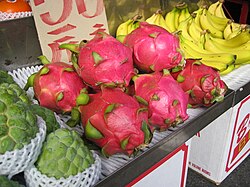
A pitaya (/pˈtaɪ.ə/) or pitahaya (/ˌpɪtəˈhaɪ.ə/) is the fruit of several cactus species, most importantly of the genus Hylocereus (sweet pitayas).
If not otherwise stated, this article's content refers specifically to the pitayas of Hylocereus species, or dragon fruit.
Vernacular names
These fruits are commonly known as "dragon fruit" as in the Chinese huǒ lóng guǒ, "fire dragon fruit", and lóng zhū guǒ, "dragon pearl fruit", the Vietnamese thanh long meaning "green dragon", the Indonesian and Malaysian buah naga, the Lao mark mang gohn, and the Thai kaeo mangkon or "dragon crystal". Other vernacular names are strawberry pear or nanettikafruit.
Distribution
The vine-like epiphytic pitaya-producing cacti of the genus Hylocereus are native to Mexico, Central America, and South America. Currently, they are also cultivated in East Asian and Southeast Asian countries such as Indonesia (especially in eastern Java), Taiwan, Vietnam, Thailand, the Philippines, Sri Lanka, Malaysia, and more recently Bangladesh. They are also found in Okinawa, Hawaii, Israel, Palestine, northern Australia and southern China.
The fruit was likely introduced by Europeans who brought fruit from the New World to other parts of the world. In the case of Taiwan, the fruit was brought in by the Dutch.
Hylocereus blooms only at night; the large white fragrant flowers of the typical cactusflower shape are among those called "moonflower" or "Queen of the Night". Sweet pitayas have a creamy pulp and a delicate aroma. It is also grown as an Ornamental plant, used in gardens as a flowering vine, and a house plant indoors.

Varieties
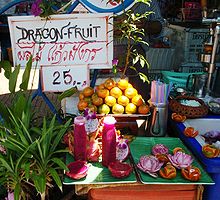
Stenocereus fruit (sour pitayas) are of more local importance, being commonly eaten in the arid regions of the Americas. They are more sour and refreshing, with juicier flesh and a stronger taste, and are relished by hikers. The sour pitaya or pitaya agria (S. gummosus) in the Sonoran Desert has been an important food source for Native Americans. The Seri people of northwestern Mexico still harvest the highly appreciated fruit, and call the plant ziix is ccapxl – "thing whose fruit is sour". The fruit of related species, such as S. queretaroensis and the dagger cactus (S. griseus), are also locally important food. Somewhat confusingly, the Organ Pipe Cactus (S. thurberi) fruit (called ool by the Seris) is the pitahaya dulce ("sweet pitahaya") of its native lands, as dragon fruit are not grown there in numbers. It still has a more tart aroma than Hylocereus fruit, described as somewhat reminiscent of watermelon; it has some uses in folk medicine.
Fruits of some other columnar cacti (mainly Cereeae) are also called "pitayas" – for example those of the Peruvian Apple Cactus (Cereus repandus), which are very rare.
Cultivation

After thorough cleaning of the seeds from the pulp of the fruit, the seeds may be stored when dried. Ideally, the fruit must be unblemished and overripe. Seeds grow well in a compost or potting soil mix - even as a potted indoor plant. Pitaya cacti usually germinate between 11 and 14 days after shallow planting. As they are cacti, overwatering is a concern for home growers. As their growth continues, these climbing plants will find something to climb on, which can involve putting aerial roots down from the branches in addition to the basal roots. Once the plant reaches a mature 10 pounds in weight, the plant may flower.
Pitaya flowers bloom overnight and usually wilt by the morning. They rely on nocturnal pollinators such as bats or moths for fertilization. Self-fertilization will not produce fruit. This limits the capability of home growers to produce the fruit. However, the plants can flower between three and six times in a year depending on growing conditions. Like other cacti, if a healthy piece of the stem is broken off, it may take root in soil and become its own plant.
The plants can handle temperatures up to 40 °C (104 °F) and very short periods of frost, but will not survive long exposure to freezing temperatures. The cacti thrive most in USDA zones 10-11, but may survive outdoors in zone 9a or 9b.
Hylocereus has adapted to live in dry tropical climates with a moderate amount of rain. The dragon fruit sets on the cactus-like trees 30–50 days after flowering and can sometimes have 5-6 cycles of harvests per year. There are some farms in Vietnam that produce 30 tons of fruit per hectare every year.
Pests and diseases
Overwatering or excessive rainfall can cause the flowers to drop and fruit to rot. Birds can be a nuisance. The bacterium Xanthomonas campestris causes the stems to rot. Dothiorella fungi can cause brown spots on the fruit, but this is not common.
Fruit

Sweet pitayas come in three types, all with leathery, slightly leafy skin:
- Hylocereus undatus (red pitaya) has red-skinned fruit with white flesh. This is the most commonly seen "dragon fruit".
- Hylocereus costaricensis (Costa Rica pitaya, often called H. polyrhizus) has red-skinned fruit with red flesh
- Hylocereus megalanthus (yellow pitaya, formerly in Selenicereus) has yellow-skinned fruit with white flesh.
Early imports from Colombia to Australia were designated Hylocereus ocampensis (supposedly red fruit) and Cereus triangularis (supposedly yellow fruit). It is not quite certain to which species these taxa refer, though the latter is probably the red pitaya.
The fruit can weigh from 150 to 600 grams; some may reach one kilogram.
Consumption
To prepare a pitaya for consumption, the fruit is cut open to expose the flesh. The fruit's texture is sometimes likened to that of the kiwifruit because of its black, crunchy seeds. The flesh, which is eaten raw, is mildly sweet and low in calories. The seeds are eaten together with the flesh, have a nutty taste and are rich in lipids, but they are indigestible unless chewed. The fruit is also converted into juice or wine, or used to flavour other beverages. The flowers can be eaten or steeped as tea. The skin is not eaten, and in farm-grown fruit it may be polluted with pesticides.
Ingestion of significant amounts of red-fleshed dragon fruit (such as Costa Rica Pitaya) may result in pseudohematuria, a harmless reddish coloration of the urine and faeces.
Several of the Padres who missionized Baja California recorded an unusual form of consumption of pitahaya that is also shared in some O'odham stories from southern Arizona. It is called the "second harvest" of pitahaya seeds. With the scarcity of fruits in their lands, the pitahaya was such a prized fruit that once it was eaten, the natives would wait for their own excrement to dry, then break it apart separating the pitahaya seeds. These seeds would be ground into a flour and eaten again, giving the pitahaya's "second harvest" it's name. Interestingly, the O'odham name for the Milky Way translates as "the second harvest of pitahaya."
Taste
The mild taste of pitaya flesh is often remarked upon, as it stands in stark contrast to the vibrant exterior. The taste has been described as being "very bland... like a melon or kiwi," with a "mild sweetness."
Nutritional information
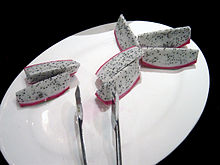
The edible parts of raw pitaya consist of mostly water and carbohydrates, with some protein and fat content. Pitayas contain slight amounts of calcium, iron, phosphorus, and other nutrients.
The fatty acid compositions of two pitaya seed oils were determined as follows:
| "Hylocereus polyrhizus" (probably Costa Rica Pitaya) | Hylocereus undatus (Red Pitaya) | |
|---|---|---|
| Myristic acid | 0.2% | 0.3% |
| Palmitic acid | 17.9% | 17.1% |
| Stearic acid | 5.49% | 4.37% |
| Palmitoleic acid | 0.91% | 0.61% |
| Oleic acid | 21.6% | 23.8% |
| Cis-vaccenic acid | 3.14% | 2.81% |
| Linoleic acid | 49.6% | 50.1% |
| Linolenic acid | 1.21% | 0.98% |
Uses
- Particularly red-skinned pitayas are a good source of Vitamin C.
- Pitayas are rich in fiber and minerals, notably phosphorus and calcium. Red pitayas seem to be richer in the former, yellow ones in the latter.
- The seeds are rich in polyunsaturated fatty acids, and in particular Red Pitayas contain very little saturated fat.
- Pitahayas also contain significant quantities of phytoalbumin antioxidants, which prevent the formation of cancer-causing free radicals.
- In Taiwan, diabetics use the fruit as a food substitute for rice and as a source of dietary fiber.
- Pitaya supposedly increases excretion of heavy metal toxins and lowers cholesterol and blood pressure. Eaten regularly, it is credited with alleviating chronic respiratory tract ailments.
Gallery
-
 Red Pitaya (Hylocereus undatus)
Red Pitaya (Hylocereus undatus)
-
 Costa Rica Pitaya (Hylocereus costaricensis)
Costa Rica Pitaya (Hylocereus costaricensis)
-
 Flesh of Costa Rica Pitayas
Flesh of Costa Rica Pitayas
-
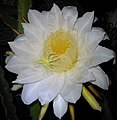 Costa Rica Pitaya flower
Costa Rica Pitaya flower
-
 Yellow Pitaya (Hylocereus megalanthus)
Yellow Pitaya (Hylocereus megalanthus)
-
 Pink dragonfruit
Pink dragonfruit
-
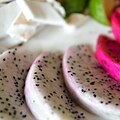 A close-up of slices of white and red Pitaya
A close-up of slices of white and red Pitaya
See also
- Opuntia - prickly pear cacti with edible "cactus figs" or "tunas" fruit
- List of culinary fruits
Footnotes
- ^ "Dragon Fruit: An Exotic, Health-Packed Fruit". Exotic Fruit for Health. 23 August 2011. Retrieved 18 September 2011.
- Dragon fruit is on its way in Bangladesh. Viddler.
- ""Thanh Long:" The Dragon Fruit". Epiphytic Cacti. November 2006. Retrieved 9 June 2012.
- http://toptropicals.com/html/toptropicals/articles/cacti/pitaya.htm
- http://www.taiwan.gov.tw/ct.asp?xItem=35870&CtNode=2181&mp=1005
- Lauri (2000)
- Felger & Moser (1985)
- Villalobos et al. (2007)
- http://www.tradewindsfruit.com/dragon_fruit.htm
- http://dragon.fruit.pitaya.fruit.foodlywise.com/growing_dragon_fruit_pitaya/growing_dragon_fruit.html
- http://www.forestmulch.com/dragon-3.htm
- Jacobs (1999)
- ^ Ariffin, Abdul Azis (2008). "Essential fatty acids of pitaya (dragon fruit) seed oil". Food Chemistry. 114 (2): 561–564. doi:10.1016/j.foodchem.2008.09.108.
{{cite journal}}: Unknown parameter|coauthors=ignored (|author=suggested) (help) - MMR (2008)
- Yetman, David. The organ pipe cactus. Vol. 114. Southwest Center series. p. 40.
References
- Agricultura Sensitiva (AS) : El cultivo de Pitaya y su posicionamiento en el mercado. Retrieved January 19, 2008.
- Felger, Richard & Moser, Mary B. (1985): People of the desert and sea: ethnobotany of the Seri Indians. University of Arizona Press, Tucson
- Jacobs, Dimitri (1999): Pitaya (Hylocereus undatus), a Potential New Crop for Australia. Australian New Crops Newsletter 11: 16.3. HTML fulltext
- Lauri, Bob (2000): Ocean Oasis Field Guide - Stenocereus gummosus. Retrieved October 1, 2007.
- Malaysian Medical Resources (MMR) (2008): Pseudohaematuria due to Dragonfruit ingestion. Retrieved February 24, 2008.
- Villalobos, Soraya; Vargas, Orlando & Melo, Sandra (2007): Uso, manejo y conservacion de "yosú", Stenocereus griseus (Cactaceae) en la Alta Guajira colombiana . Acta Biologica Colombiana 12(1): 99-112. PDF fulltext